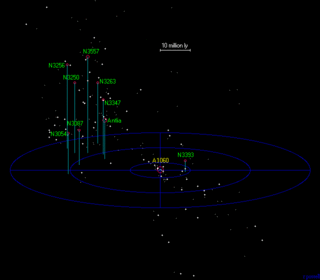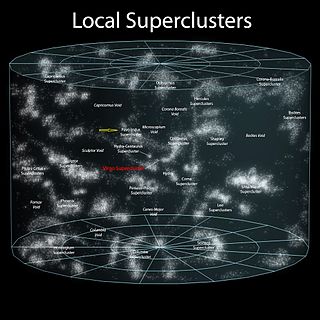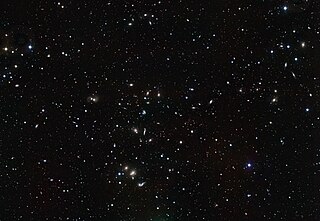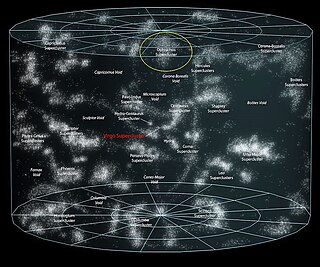
A supercluster is a large group of smaller galaxy clusters or galaxy groups; they are among the largest known structures in the universe. The Milky Way is part of the Local Group galaxy group, which in turn is part of the Virgo Supercluster, which is part of the Laniakea Supercluster, which is part of the Pisces–Cetus Supercluster Complex. The large size and low density of superclusters means that they, unlike clusters, expand with the Hubble expansion. The number of superclusters in the observable universe is estimated to be 10 million.

A galaxy cluster, or a cluster of galaxies, is a structure that consists of anywhere from hundreds to thousands of galaxies that are bound together by gravity, with typical masses ranging from 1014 to 1015 solar masses. They are the second-largest known gravitationally bound structures in the universe after some superclusters (of which only one, the Shapley Supercluster, is known to be bound). They were believed to be the largest known structures in the universe until the 1980s, when superclusters were discovered. One of the key features of clusters is the intracluster medium (ICM). The ICM consists of heated gas between the galaxies and has a peak temperature between 2–15 keV that is dependent on the total mass of the cluster. Galaxy clusters should not be confused with galactic clusters (also known as open clusters), which are star clusters within galaxies, or with globular clusters, which typically orbit galaxies. Small aggregates of galaxies are referred to as galaxy groups rather than clusters of galaxies. The galaxy groups and clusters can themselves cluster together to form superclusters.

The Virgo Supercluster or the Local Supercluster is a mass concentration of galaxies containing the Virgo Cluster and Local Group, which itself contains the Milky Way and Andromeda galaxies, as well as others. At least 100 galaxy groups and clusters are located within its diameter of 33 megaparsecs. The Virgo SC is one of about 10 million superclusters in the observable universe and is in the Pisces–Cetus Supercluster Complex, a galaxy filament.

The Great Attractor is a region of gravitational attraction in intergalactic space and the apparent central gravitational point of the Laniakea Supercluster of galaxies that includes the Milky Way galaxy, as well as about 100,000 other galaxies.

The Hydra–Centaurus Supercluster, or the Hydra and Centaurus Superclusters, is a supercluster in two parts, the closest neighbour of Virgo Supercluster. It is located about 39 Mpc (127 Mly) away.
The Northern Local Supervoid is a region of space devoid of rich clusters of galaxies, known as a void. It is the closest supervoid and is located between the Virgo (Local), Coma and Hercules superclusters. On the sky, it is located between Boötes, Virgo, and Serpens Caput constellations. It contains a few small galaxies and galaxy clusters, but is mostly empty. The faint galaxies within this void divide the region into smaller voids, which are 3–10 times smaller than the supervoid. The center is located 61 Mpc (199 Mly) away at approximately and it is 104 Mpc (339 Mly) in diameter across its narrowest width.

Abell 2029 or A2029 is a large and relaxed cluster of galaxies 315 megaparsecs away in the constellation Virgo. A2029 is a Bautz–Morgan classification type I cluster due to its large central galaxy, IC 1101. Abell 2029 has a diameter of 5.8–8 million light-years. This type of galaxy is called a cD-type brightest cluster galaxy and may have grown to its large size by accreting nearby galaxies. Despite its relaxed state, it is the central member of a large supercluster which shows clear signs of interaction.

The Sloan Great Wall (SGW) is a cosmic structure formed by a giant wall of galaxies. Its discovery was announced from Princeton University on October 20, 2003, by J. Richard Gott III, Mario Jurić, and their colleagues, based on data from the Sloan Digital Sky Survey.

The Shapley Supercluster or Shapley Concentration is the largest concentration of galaxies in our nearby universe that forms a gravitationally interacting unit, thereby pulling itself together instead of expanding with the universe. It appears as a striking overdensity in the distribution of galaxies in the constellation of Centaurus. It is 650 million light-years away (z=0.046).

The Pavo–Indus Supercluster is a neighboring supercluster located about 60–70 Mpc (196–228 Mly) away in the constellations of Pavo, Indus, and Telescopium. The supercluster contains three main clusters, Abell 3656, Abell 3698, and Abell 3742.

The Hercules Cluster is a cluster of about 200 galaxies some 500 million light-years distant in the constellation Hercules. It is rich in spiral galaxies and shows many interacting galaxies. The cluster is part of the larger Hercules Supercluster, which is itself part of the much larger Great Wall super-structure.

In cosmology, galaxy filaments are the largest known structures in the universe, consisting of walls of galactic superclusters. These massive, thread-like formations can commonly reach 50/h to 80/h Megaparsecs — with the largest found to date being the Hercules-Corona Borealis Great Wall at around 3 gigaparsecs (9.8 Gly) in length — and form the boundaries between voids. Due to the accelerating expansion of the universe, the individual clusters of gravitationally bound galaxies that make up galaxy filaments are moving away from each other at an accelerated rate; in the far future they will dissolve.

The Laniakea Supercluster is the galaxy supercluster that is home to the Milky Way and approximately 100,000 other nearby galaxies.
Abell 2162 is a galaxy cluster in the Abell catalogue located in the constellation Corona Borealis. It is a member of the Hercules Superclusters, the redshifts of the member galaxies of which lie between 0.0304 and 0.0414. The cluster hosts a massive Type-cD galaxy called NGC 6086.
The Saraswati Supercluster is a massive galaxy supercluster about 1.2 gigaparsecs (4 billion light years) away within the Stripe 82 region of SDSS, in the direction of the constellation Pisces. It is one of the largest structures found in the universe, with a major axis in diameter of about 200 Mpc (652 million light years). It consists of at least 43 galaxy clusters, and has the mass of 2 × 1016 M☉, forming a galaxy filament.

ESO 444-46 is a class E4 supergiant elliptical galaxy; the dominant and brightest member of the Abell 3558 galaxy cluster around 640 million light-years away in the constellation Centaurus. It lies within the core of the massive Shapley Supercluster, one of the closest neighboring superclusters. It is one of the largest galaxies in the local universe, and possibly contains one of the most massive black holes known. The black hole's mass is very uncertain, with estimates ranging from as low as 501 million M☉, to as high as 77.6 billion M☉.

Ophiuchus Supercluster is a nearby galaxy supercluster in the constellation Ophiuchus. The supercluster forms the far wall of the Ophiuchus Void; it may also be connected in a filament with the Pavo-Indus-Telescopium Supercluster and the Hercules Supercluster. This supercluster is centered on the cD cluster Ophiuchus Cluster, and has at least two more galaxy clusters, four more galaxy groups, and several field galaxies as members.

Draco Supercluster (SCL 114) is a galaxy supercluster in the constellation Draco. It is located at a distance of 300 Mpc h−1 on a side of a void of diameter of about 130 Mpc h−1. The near side of the void is bordered by the Ursa Major supercluster. The estimated size of the supercluster reaches 410 million light years and a mass of 1017 M☉, making it one of the largest and most massive superclusters known in the observable universe.















